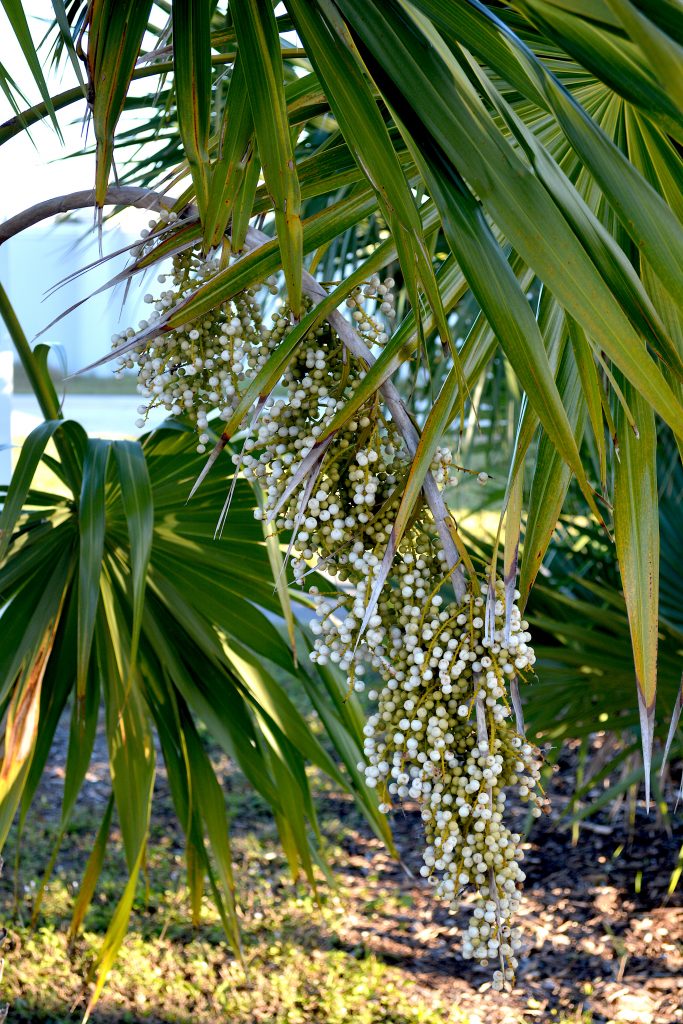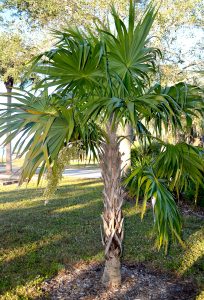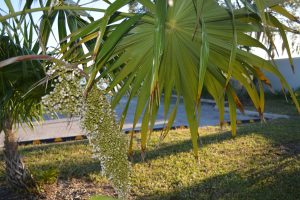
The white fruit of the Thrinax radiata, Florida Thatch Palm. Photo by Green Deane
Almost all white berries are not edible. Is there half-a-dozen on earth that are? It seems we have two in Florida, the White Indigo Berry, and Florida Thatch Palm.

The Florida Thatch Palm might be found more in landscaping than in nature.
On teaching trips to south Florida I saw a palm with small white fruit. Twice I tasted them. No particular flavor but more importantly no burning from calcium oxalates which is usually the first sign a palm fruit is not edible (same with most large-leaf “elephant ears” and the like.) It is Thrinax radiata, the Florida Thatch Palm, so called because it was used to thatch hut roofs (which also suggests it was more prolific in the past.) Its fibers and netting have been found in pre-Columbian sites on Marco Island. It was used for rope into the 19th century. On page 670 of Florida Ethnobotany by the late Dr. Daniel Austin he writes: “Fruits are sweet and edible.” Then he says “the fiber has been used to stuff pillows and mattresses.” Like many palms it’s had several names Cocothrinax martii, C. radiate, Thrinax floridana, T. martii, T. multiflora and T. wendlandiana. It grows on southern coast of Florida, the Florida Keys, Bahamas, western Cuba, Cayman Islands, Jamaica, Hispaniola, Puerto Rico, Honduras, Nicaragua, the eastern coast of the Yucatan Peninsula in Mexico and Belize. This palm likes it warm. The one I see regularly — planted — is in the southeastern corner of Bayshore Park in Port Charlotte (which in theory is out of its range.)
Thrinax means “trident” in Greek, referring to the shape of the frond center where the leaves radiate hence radiata.
Green Deane’s Itemized Plant Profile

The fronds are circular. Photo by Green Deane
IDENTIFICATION: It’s a slender, slow-growing palm that can reach 30 feet but is usually much shorter. The trunk is matted with fiber between old leaf bases. The base often has protruding roots. A fan palm it usually has between 12 and 20 frond. Fronds are green above with yellow ribs, lighter green or yellow green underneath with a distinct spear shape protruding from the frond’s center. White fruit. It differs from both the thatch palm (Leucothrinax morrisii, syn. Thrinax morisii) and the silver palm (Coccothrinax argentata) by lacking the silvery white leaf under surfaces. When grown in full sun the canopy is globular. When grown in shade the fronds are widely dispersed with an open-air canopy.
TIME OF YEAR: Fruits continuously but produces the most in the spring.
ENVIRONMENT: Salt, wind and drought tolerant. It tolerates high ph. Can survive temperatures down to 26F. Does not appear to be bothered by Ganoderma Butt Rot.
METHOD OF PREPARATION: Seed pulp is edible. Its roots and shoots were considered tonic and restorative.

